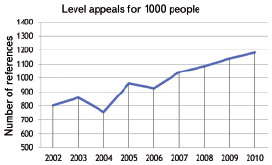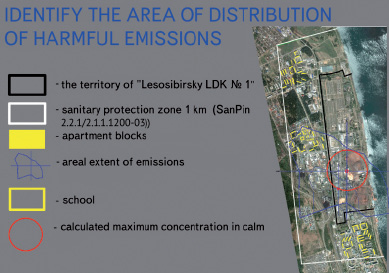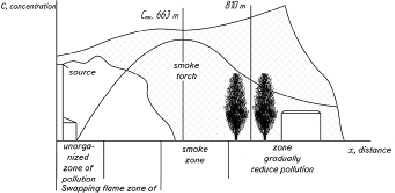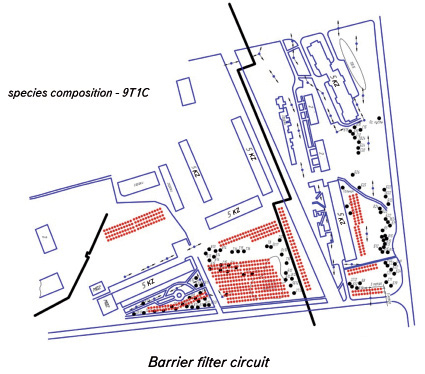Industrial pollution of atmospheric air is one of the basic urbanization problems, and it mostly refers to small and medium monocities that are concentrated around one or several industrial enterprises. Transport pollution becomes the most important issue in big cities.
Cleaning facilities on sources, transiting industrial zones outside city borders, creation of gardening system, etc. is `used to solve the problem of air quality.
City gardening system is an interrelated, equal allocation of urban plantings, defined by a formed development system that implies relations with plantings outside a city.
An area of natural landscape, preserved in a city even as a small introduction into an urbanized environment, usually creates a unique image of the city, takes part in filtering hazardous substances, etc.
Modern theory of city planning contains an idea of greening systems that pierce a city and have their prior purpose – enhance the city environment. According to this purpose, the structure of «green wedges» that unites planted territories, necessary for recreation, is considered optimal. Planted territories, including green wedges, play a part of protective areas that barrier certain parts of a city from the impact of super-urbanization.
A specific and generally unfavourable ecological situation is created in cities. Aerial pool of a city is constantly polluted by wastes of industrial production, exhaust gases, and dirt.
The degree of atmospheric pollution depends on the following natural factors: wind direction and speed, air temperature and humidity, landscape relief, and vegetative nature.
A so-called smog, or thick mist that contains a high concentration of industrial wastes, is formed in big industrial cities during still weather. Smog often causes serious diseases among the population.
Solid dust fractions in floating condition interact with water fumes that also feed the atmosphere, and they are substances that have a negative effect upon breath organs of a person. Temperature regime of a city and humidity of urban air are exposed to greater oscillations than on countryside territories. It often creates uncomfortable conditions for urban population, especially during especially cold or hot days.
Another negative factor in a person’s urban life is city noise. Urban noise level often exceeds acceptable norms, it has an unfavourable effect on population health.
An intense growth of cities is often described by individual construction methods nowadays and, therefore, massive real estate development of urban and suburban territories with typed houses and constructions. Massive development with typed buildings often results in monotony and dreadness of architectural image of a city, thus making it significantly poorer.
One of the most significant urbanization problems of modern times is to overcome this monotony and dreadness while preserving quick industrial construction methods, thus achieving an expressed architectural image of a city.
Harmonic development of a person is impossible without a close relation with nature. Communication with nature serves as a powerful mean of upbringing the beauty, mastering legislations of life. Such interaction reliefs these strains significantly, thus allowing for recovery of human organism.
The negative influence of unfavourable factors of urban life upon a person can be decreased significantly by a skillful allocation of green planting in a city.
Green plantings have an important meaning in filtering urban air from dust and gases. Dust remains on tree and bush leaves and then is washed down to ground with atmospheric fallouts. Spread or motion of dust is also kept by lawns that slow down dust that is carried by wind.
Air contains 42 % less dust in summer period and 37 % less dust in winter period among green plants than at open space.
Green plantings decrease concentration of hazardous gases in the air significantly. Dangerous fumes are absorbed by plants during the process of transpiration, and solid fractions of aerosols remain on tree leaves, trunks, and branches.
Significance of greening dwelling territories in a direct contact with industrial enterprises depends on terms of air pollution and presence of hazardous substances in the air.
Green planting is not carried out on a proper level in small towns due to a shortage in finance. There are often no programmes of greening, but there are programmes of removing «emergency» trees. Considering these problems, green planting should be carried out in specific, most efficient areas, and such measures will have the greatest effect in terms of limited financing. A special method of creating filtering barrier that also served as greening element, has been developed to solve this problem.
1. Revealing hazardous discharge sources in dwelling districts city.
2ю Analyzing concentration of hazardous discharges in dwelling districts of a city during the previous 10 years.
3. Revealing the most hazardous discharges that have a negative effect upon a human health.
4. Analyzing population diseases during a definite period (oncological diseases mainly).
5. Measuring concentration of hazardous substances in air via sampling probe.
6. Revealing outspread area of hazardous discharges considering wind rose, formed according to the data of previous 5–7 years. Facilitating Unified Program of air pollution estimation «Ecolog», variant 3, Standard.
7. Creating 3D model of hazardous discharges outspread considering the formed wind rose.
8. Establishing (All-union normative document – 86 including SN 369-74) the distance of maximum hazardous substances’ concentration and defining location of dwellings.
9. Defining the necessary forest and bush cultures to create filtering barrier (greening).
10. Creating planting scheme of the selected kinds directly in a studied district.
11. Establishing project efficiency and costs of its realization.
The city of Lesosibirsk (Krasnoyarsk region) has been selected to approbate the methodology. Dwelling territory of Lesosibirsk is located in a sanitary-protective zone (that is unacceptable according to Construction norms and rules 2.07.01-89) of industrial enterprises of hazard class I that should have a border in 1 km from an enterprise and 40 % greening degree (Sanitary rules and norms 2.2.1/2.1.1.1200-03), but in fact – less than 20 %. Thus, enterprises have a negative impact upon the environment and health of population. This fact is testified by a high concentration level of hazardous substances in Lesosibirsk atmosphere. The list of one hundred most dirty cities of Russian Federation according to atmosphere pollution index puts Lesosibirsk at the 16th place in 2010 and 13th place in 2011.
An increase in initial population disease rate, high level of oncological diseases and resulting deaths is registered in Lesosibirsk. One of the factors that influence population health is exceed of an utmost acceptable concentration of hazardous substances in atmosphere and a high index of atmospheric pollution.
Degradation of air quality becomes an important ecological problem of large and industrial cities. Lesosibirsk is a center of Krasnoyarsk region wood industry, numerous wood processing plants are located there: JSC «Lesosibirskiy wood industrial complex № 1», CJSC «Novoyeniseyevskiy wood and pine industrial complex», JSC «Maklakovskiy wood industrial complex». Production of timber, wood fiber plates, and items of wood is linked to complex technological processes that result in atmospheric pollution. A number of boiler houses, placed within city borders also contribute to air pollution. Presence of such stationary sources of waste increases contents of phenols, formaldehydes, benzo[def]phenanthrene, carbon oxide, weighed substances, etc. These substances have a proved negative effect of population health. Picture 1 represents the data according on initial disease rate in Lesosibirsk.
According to the report collection «Condition of environmental objects’ pollution at the territory of Krasnoyarsk region, republic Khakasiya and Tyva» major sources of atmospheric pollution in Lesosibirsk are JSC «Lesosibirskiy wood industrial complex № 1», CJSC «Novoyeniseyevskiy wood and pine industrial complex», JSC «Maklakovskiy wood industrial complex». Studying stationary pollution sources, we outline heat station HS-1 in the workshop of Wood fiber plates JSC «Lesosibirskiy wood industrial complex № 1», as they are located in a direct contact with dwelling territories. Wood splinter is used as fuel at HS-1, and total discharge of volatile substances equal 85 %, while this index equals 58 % for coal. Wood splinter has a lower heat output coefficient than coal, and, therefore, a greater mass of splinter is used, so the volume of volatiles is increased.
We have calculated the areal of hazardous discharges outspread considering wind rose according to the data of the previous 7 years, the data is provided in Fig. 2.
The received data proves that dwelling houses of microdistrict № 7 are located in areal of pollution.

Fig. 1

Fig. 2
According to sanitary norm SN 369-74, we have carried out calculations of maximum concentration range, it equals 663 meters. The estimations are carried out for heat station HS-1 according to All-union normative document – 86, issued instead of SN 369-74, the results are provided in Fig. 3.
As Fig. 3 shows, dwelling houses of microdistrict 7 are located in the area of graduate decrease in pollution level, therefore, it is necessary to create a filtering barrier that will protect houses from the remaining hazardous substances.
Using the Unified Program of air pollution estimation «Ecolog», variant 3, we have carried out calculations of hazardous substances in the atmosphere of Lesosibirsk that are included into Index of atmospheric pollution – phenols, formaldehydes, benzo[def]phenanthrene, carbon oxide, weighed substances. Calculations in the programme are carried out according to the data on sources of pollution during the period winter-summer. The received data testifies the calculated distances of maximum concentration.

Fig. 3
We have considered researches on green plantings while studying specific kinds and cultures. Below are provided researches by botanic department of Kemerovo state university on investigating plants’ stability in conditions of industrial grounds and dwelling districts of Kemerovo.
Table 1
Gas absorbing ability of plants (grams per 5 kgs of raw green mass)
|
Plants |
SО2 |
NO2 |
NH3 |
|
Balsam poplar |
30 |
23 |
13 |
|
Common birch |
25 |
25 |
5 |
|
Tillet |
28 |
20 |
3 |
|
Rock maple |
13 |
8 |
2 |
|
Lawn grass |
105 |
65 |
60 |
|
Bushes |
75 |
60 |
50 |
Our attention has also been drawn to researches by doctor of biology Yuriy Zakharovich Kulagin, head of forest study laboratory (1971–1983) of the Institute of biology in Ufa [2].
After studying normative documents on green planting, we have selected several cold-resistant kinds that grow well within the borders of Lesosibirsk and also added Laurel-leaved poplar (with no fluff), bred by Siberian institute of physiology and biochemistry of plants. It doesn’t produce fluff (unseasoned aglets fall off) and holds a leaf 1–1,5 months longer (as a leaf is the main barrier for hazardous substances, a tree can absorb more fumes throughout the year) [1].
Table 2
Gas absorbing ability of Siberian poplar
|
Pollution type |
Per one day |
During vegetative period |
|
SO2 |
20 mg |
130–180 g |
|
NO2 |
12 mg |
80–120 g |
|
NH3 |
8 mg |
50–80 g |
|
Phenol |
0,3 mg |
2–3 g |
|
Dust (weighed substances) |
7-8 mg |
50 kg |
Our search stops at Laurel-leaved poplar (with no fluff) as it grows rapidly, has a high gas absorbing ability, isn’t pretentious to soil and other conditions, doesn’t have negative attributes of poplars that grow in Enisey district (fluff, chamaemyid disease). We shall add 10 % of pine into its natural composition as pines produce phytoncides and other substances that provide for healing lung diseases. Apart from that, common pine is one of the leaders in noise absorption among trees.
Fig. 4 shows the part of microdistruct-7 on which we suggest creation of filtering barrier.
In conclusion we would like to outline the efficiency of this methodology. It is defined by the fact we can select the most efficient place for green planting and the best kind to create filtering barrier.

Fig. 4
Table 3
Comparison of cold-resistant kinds of green planting
|
Name of tree |
Gas resistance |
Tree height (m) |
Nurseling height (m) |
Height in 10 years after planting (m) |
Nurseling price, rubles |
|
Laurel-leaved poplar (with no fluff) |
+ |
30–35 |
1,5 |
10 and over |
1000 |
|
Common pine |
– |
20–40 |
1,5 |
up to 5 |
250 |
|
Rowan tree |
+ |
10–15 |
1,0 |
up to 5 |
150 |
|
Balsam poplar |
+ |
30–35 |
1,0 |
10 and over |
200 |
|
Weeping birch |
– |
25 |
1,0 |
up to 5 |
150 |
|
Siberian spruce |
– |
30–45 |
1,0 |
up to 2 |
250 |
Библиографическая ссылка
Aksyonov N.V., Kozhevnikov A.K., Rubinskaya A.K., Sedrisev D.N. METHODOLOGY OF THE PROCESS OF GREENING DWELLING TERRORORIES IN INDUSTRIAL DISTRICS OF A CITY // Международный журнал экспериментального образования. 2014. № 2. С. 43-47;URL: https://expeducation.ru/ru/article/view?id=4620 (дата обращения: 23.12.2025).

